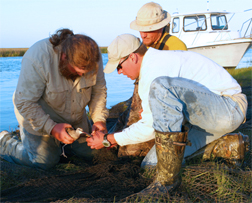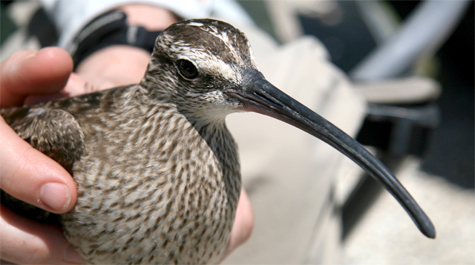Hope adds more pieces to the whimbrel puzzle
In 2008, a female whimbrel named Winnie made national news when she set a distance record for whimbrels in a 146-hour, 3,200-mile flight from the Eastern Shore to breeding grounds in the Mackenzie River basin near the Alaska-Canada border. At an average speed of 22 miles per hour, Winnie’s apparently nonstop flight overturned conventional scientific thinking
 about whimbrels, their habits and their migration patterns.
about whimbrels, their habits and their migration patterns.This year, a rambling, 5,600-mile odyssey by a bird named Hope continues the rewriting of the natural history of Numenius phaeopus. Hope surprised scientists by visiting both of the well-known northern whimbrel breeding grounds—and apparently not breeding. Bryan Watts, director of the CCB, said part of the explanation lies in the late arrival of the arctic summer.
“They’ve had an incredibly late summer,” Watts said. “They’ve had a lot of snow cover and ice up to the north, partly covering the breeding range of a lot of species, including geese and shorebirds. It looks like a lot of these birds have gotten up there and then probably not been able to breed. The breeding season is so short that if the thaw-out is late, then they’re just not going to breed for the year.”
Researchers from the Center for Conservation Biology and the Nature Conservancy track the movements of Winnie, Hope and other whimbrels by satellite. For the past two years, the scientists have been trapping these curved-billed wading birds at their migratory staging areas on the Eastern Shore. The birds are released unharmed, but wearing a tiny state-of-the-art satellite-tracking device that lets researchers follow the bird’s northward migration. They’ll repeat the process in the fall, as the birds stage for their trip south.
“This spring we put out five solar powered transmitter units. These are the same units we used last year on two birds,” explained Libby Mojica, a research wildlife biologist at the center. “This year, we decided to increase the number of birds. We’re doing five in the spring and then we’ll be putting out an additional four in the fall.”
Mojica said the five transmitter-bearing whimbrels were released between May 18 and 22. Whimbrels use the Eastern Shore as a refueling point on their way north from the birds’ winter grounds that extend down both coasts of South America. They feed on the crabs abundant in the creeks and inlets of the Delmarva Peninsula, storing up energy to continue north to one of the two breeding grounds used by the species.
Watts explained that there are two populations of whimbrels. The western group uses the breeding grounds of Alaska’s North Slope, while the eastern group breeds in Canada, west of James Bay and Hudson Bay. This year, a transmitter-bearing whimbrel named Boxer flew straight up to James Bay, then came right back to Box Tree Creek, where he had been trapped in May. Another apparent victim of the late northern summer, Watts said Boxer “blew off the breeding season” and flew south.
“This is something we’ve been interested in. We’ve thought that these birds are really spatially structured—they go to specific sites. So Boxer is using the same staging area for the fall that it used in the spring,” Watts said. “It’s pretty wild to have that bird staging on that same little creek in the spring and again in the fall.”
While Boxer confirmed scientific beliefs about migratory habits, other whimbrels play by their own rules. Last year, Winnie, expected to take the straight shot to James Bay like other eastern whimbrels, flew to Alaska instead. “Nobody expected that,” Mojica said. “Some shorebird biologists were questioning whether Winnie was just a fluke.”
This spring, Hope took a rather roundabout journey to James Bay, going through Pennsylvania and New York, even veering off northeast before heading for the mouth of James Bay. As expected, she spent several days in and around the eastern breeding grounds. Then she tossed the script and took off for the western breeding grounds.
“That’s totally new information to us,” Watts said. “The eastern and western population of whimbrels were thought to be distinct and not overlapping. Then last year we had Winnie, who was clearly staging here with the eastern population, then went west. But Hope actually went up to the eastern breeding grounds—and then went over to the western area. Completely unexpected.”
Watts offered a couple possible scenarios for Hope’s behavior. One is that Hope is a westerner that for some reason staged at the eastern grounds. The second is that she is an eastern bird who found her proper breeding grounds inhospitable, likely because of the late spring, and set off for the western grounds.
“The former is more likely, because it would seem odd that the eastern population would know where the western population is breeding,” Watts said. “But it’s hard to say.”
As of July 8, the satellite tracking system showed Hope near the Mackenzie River delta, “hanging around up there,” as Watts said. It’s doubtful if she will breed this season, he added.
The transcontinental journeys of Hope and Winnie not only reveal new information about the life cycle of shorebirds, Watts said, but also underscore the environmental importance of the Delmarva Peninsula, which includes the state of Delaware as well as the eastern shores of Maryland and Virginia. Evidence is growing, he said, that the rich tidal waters of Delmarva are an important refueling area for both eastern and western populations.
The Center for Conservation Biology is a joint program of the College of William and Mary and Virginia Commonwealth University.
















